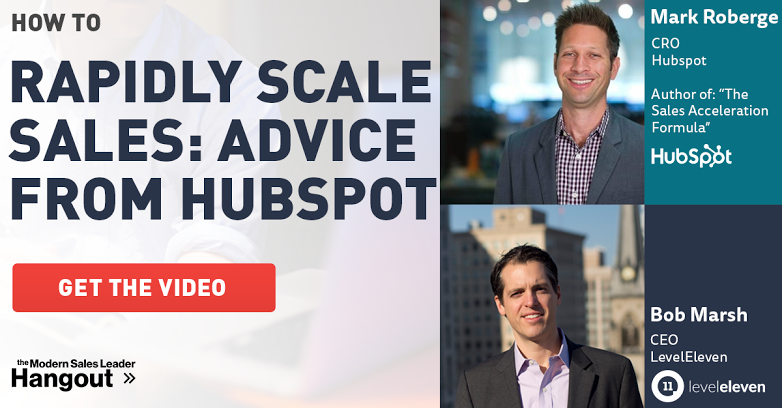 Mark Roberge was not your typical chief revenue officer.
Mark Roberge was not your typical chief revenue officer.
For one, he started his career as a computer programmer. With a degree from MIT, he’s been trained to view the professional world through the lense of data, technology and science.
So when he came to Hubspot nine years ago as the fourth employee, he applied that lense to build the sales team.
The result? Not only did Mark grow the Hubspot customer base from 0 to more than 10,000 customers, but he expanded the sales and service organization from 1 to 425 employees both in the U.S. and internationally. Now, he’s a senior lecturer at the Harvard business school and the author of The Sales Acceleration Formula.
That’s why we asked him for some expert advice on scaling sales. Here’s what he told us.
15 Prescriptions for Scaling Sales from Hubspot’s Mark Roberge
1. “Some sales leaders don’t have comfort [with numbers], some do. Of course, you can still be a sales leader if you don’t have a tremendous comfort with numbers. I would just encourage you to think early on about bringing on a sales ops person to complement you.”
2. “[I brought in sales ops] around year two, and I think we had 20 reps, maybe a little more.”
3. “There were three critical support staff that I needed to scale. By support staff, I mean not quota-carrying people. For me, the big three were recruiter, trainer and ops.”
4. “We were largely inbound lead generation, even from the beginning. It took us years before we had to find other mediums to generate demand and appointments.”
5. “In the scale-up process, I do feel that the industry is a little too quick to send these inbound leads directly to business development reps. Just think about it conceptually for a second: On a occasion, you probably get a vice president or C-level executive come to your website and fill out a lead form from a perfect-fit company. If that person is going to a BDR … I’d think twice about that, because that’s a red-hot lead, it’s inbound, it’s the perfect decision-maker, and now you’re sending that out to a 23-year-old with less than a year of sales experience.”
6. “I think BDRs are a good thing, but I think the industry in some situations has overshoot largely how they handle inbound leads.”
7. “I think lead scoring is great. I’m not sure that it’s the best model to use to decide when a lead should be passed to the sales team, nor how many leads the salesperson should get.”
8. “Lead scoring is very effective to understand how warm a lead might be and to guide some priorities, etc. But underneath the lead score, typically the algorithm is relatively complicated, such that it’s difficult to predict all the permutations that could [for example] get a lead score above 70. It works if a really high priority person downloaded something. But if it means an intern came in and clicked on something 17 times and that just happened to get the lead score over 70, that’s not good. And it’s hard to write the algorithm to prevent the bad situations and allow the good ones.”
9. “If you are in scale mode — you’ve got a couple dozen reps, and you have some inbound lead flow, and you have to also cold call — what I might suggest at this stage is to consider specializing the team by outbound vs. inbound.”
10. “[When managers close deals for reps], it takes away the confidence from the rep and it also makes them lazy. It just doesn’t scale. What I realized was that our best sales managers were coaches.”
11. “The really good coaches and managers appreciate where the salesperson is, and know the one or two things that would get them [to the next level], and they hone in on that.”
12. “When I look at a rep, there are 80 things that I could possibly coach them on. The metrics guide me as to where to focus that time that’s going to make the biggest difference.”
13. “[I wanted] sales managers to spend as much time as possible coaching and to use metrics to drive the diagnosis and the personalization of the coaching plan.”
14. “You have to start with the buyer and build out that buyer’s journey, then build a sales process that supports that buyer journey.”
15. “The stages in your CRM, ideally — it’s not always possible, but wherever possible — should be based on buyer actions not seller actions.”
Mark shared much more on the most recent broadcast of the Modern Sales Leader Hangout. Check out the whole interview below:




